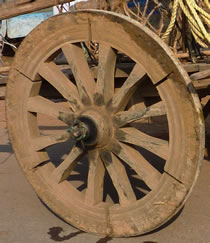BUDDHA'S FIRST NOBLE TRUTH
Please first read "Buddhism, Dukkha, and Repetitions."In Buddha's time, the word Dukkha was used to describe when a wheel was not turning smoothly on its axle.
 The invention of continuous rotary motion dates from around 3,500 BCE. This involved the potter's wheel, the spinning wheel and the solid wooden cartwheel.
The invention of continuous rotary motion dates from around 3,500 BCE. This involved the potter's wheel, the spinning wheel and the solid wooden cartwheel.
The first spoked wheel developed around 2,000 BCE. The invention of steel, around 1,500 BCE. furnished a reinforced rim and protected hubroom. The Development of The Wheel is a fascinating subject.
Each of these developments took hundreds of years, but by Buddha's time in 500 BCE., the spoked cartwheel was generating a cultural revolution.
The wheel was the epitome of self-perpetuating motion, with the possibility of momentum. It enabled a new form of mobility and transport of people and goods.
Imagine the fascination people felt when they first saw this phenomenon, similar to natural peoples these days when they first see an aeroplane. Wheels were the future. Wheels meant status. Everyone wanted wheels.
But ancient wooden wheels often squeaked, snagged, grinded and wobbled, and the hub needed constant maintenance in order to run smoothly. Dukkha described when the turning of a wheel was problematic.
Dukkha was not just an abstract concept as it is in modern times, it was a very real daily fact of life.
In Buddha's time this was an extremely important and commonplace word. Such words tend to have a very broad usage in all areas of life, when referring to anything being inefficient or going wrong. It was in all probability, also used as a swear word.
There is one other fascinating message hidden in the symbolism of the old-fashioned cartwheel, and this would have been obvious to anyone living in those times : the hard wheels on the soft dirt roads made tracks – habitual ruts – karmic ruts.
Modern suggestions for the interpretation of Dukkha are : suffering, anxiety, distress, unsatisfactory, frustration and stress. (https://en.wikipedia.org/wiki/Dukkha 2019, 2020, 2021).
To reduce the meaning of Dukkha to a question of semantics is ridiculous.
For Buddha, this was not a question the literal meaning of the word Dukkha. In those days everyone knew exactly what Dukkha meant. Buddha's question was what is the problem with life's wheel? What is going wrong?
In many texts, it is written that the Five Aggregates are Dukkha. The Aggregates are five umbrella terms which explain how we experience the world. They describe the process: manifest form, sensation, perception, concepts and consciousness.
The way we sense life, our sensory apparatus is Dukkha, is not running smoothly.
The Aggregates apply to all of our senses: touch, taste, smell, sound, sight, and thought. In Buddhism, thoughts are considered as manifest forms or 'mind-objects', the Aggregates apply to how the mind senses its own thoughts. In other words, the mind sensing its thoughts, functions in the same way as the eye sees a sight, or the ear hears a sound.
So, to be exact, the First Truth tells us: Our sensory apparatus is problematic, it's not running smoothly.
The Aggregates are further clarified in The Five Aggregates.
Dukkha In Depth develops all the background material.
Traditional and conventional ideas on the First Noble Truth are discussed in Suffering: The Traditional First Noble Truth.
Please continue with The Second Noble Truth – The Origin of Dukkha
Back to Dukkha in Depth
Back to Chapter Four : Buddhism and Wheels
Back to THE PANORAMA SENSES Priority Pages